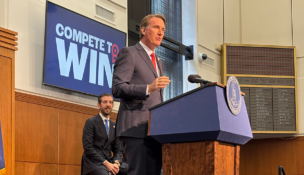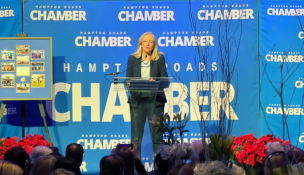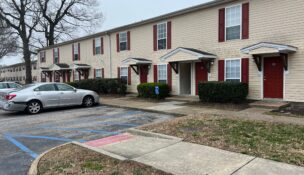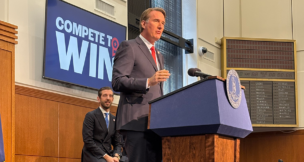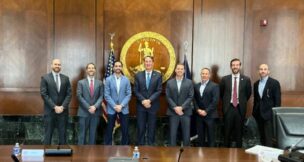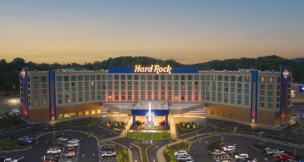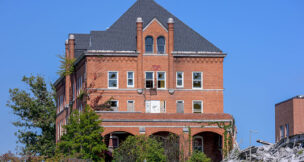NASA Langley could lose 672 jobs under Trump’s proposed budget
Proposed FY26 budget slashes NASA funding by 25%
Beth JoJack //June 6, 2025//

The NASA flag waving along with the American flag in the background. Taken March 5, 2021, in Washington, D.C. Photo by AdobeStock

The NASA flag waving along with the American flag in the background. Taken March 5, 2021, in Washington, D.C. Photo by AdobeStock
NASA Langley could lose 672 jobs under Trump’s proposed budget
Proposed FY26 budget slashes NASA funding by 25%
Beth JoJack //June 6, 2025//
SUMMARY:
• White House’s proposed FY 2026 budget cuts NASA funding by $6 billion
• 672 jobs could be eliminated at NASA Langley in Hampton
• NASA may mothball five of its 12 national wind tunnels
• NASA Langley oversees seven wind tunnels
President Donald Trump’s proposed fiscal year 2026 budget would put 672 civil servants at NASA Langley Research Center in Hampton out of work.
If approved by Congress, the White House’s suggested budget would cut the civilian workforce by about 32% across the entire agency, according to a technical supplement released last week.
The president’s suggested budget would cut NASA’s funding from $24.8 billion to $18.8 billion, a roughly 25% decrease. It would be NASA’s smallest budget since FY 1961, according to The Planetary Society, a California-based space advocacy organization.
For FY 2025, NASA Langley has a civilian workforce that’s estimated to be 1,730 employees. The proposed budget would dial that back to 1,058 workers in FY 2026, according to the technical document. Brittny McGraw, a spokesperson for Langley, said Langley does not have information to share outside of budget documents.
If the budget is approved, NASA’s centers, like NASA Langley, will “explore cross-mission retraining opportunities for employees whenever possible, offer targeted buyouts in selected surplus skill areas, and continue to identify, recruit and retain a multi-generational workforce of employees who possess skills critical to the agency,” the document stated.
Additionally, the Trump administration’s proposal aims to take the ax to 41 NASA science projects, according to The Planetary Society, which also noted that cut would equal one-third of NASA’s science portfolio.
U.S. Sen. Mark Warner, Virginia’s senior Democratic senator, called the cuts “dreadful news” during a Wednesday media call. “Cutting research, cutting that kind of innovation, is not only bad for Hampton Roads, but is also, candidly, bad for Americans’ competitiveness,” he said.
U.S. Rep. Bobby Scott, D-Newport News, agreed.
“NASA provides invaluable research and resources to explore the planets in our solar system and help us better understand our oceans, weather and climate,” he said in a statement. “And much of this work is being done in Hampton Roads at NASA Langley. The cuts to NASA’s funding and staff proposed by the Trump administration will put the United States behind in our pursuit to advance science and protect our communities from threats like climate change and sea level rise.”
Additionally, the technical document noted NASA Langley will replace its 84-year-old vertical spin tunnel with a new flight dynamics research facility in 2026. In 2022, Langley held a groundbreaking event for what was then a $43 million project.
NASA Langley currently manages seven wind tunnels, located in Hampton, within NASA’s Aerosciences Evaluation and Test Capabilities (AETC) portfolio. Of NASA’s 12 wind tunnels, the proposed budget if passed would put five tunnels into stand-by mode, meaning they would receive minimal maintenance and workforce resources. The locations of the tunnels are not specified in the document.
U.S. Sen. Tim Kaine promised to fight the suggested NASA cuts tooth and nail.
“Why would you hobble NASA programs unless you are trying to advantage Russian and Chinese space programs?” he said in a statement. “These proposed cuts, if the House and Senate pass them, would destroy NASA as we know it, and have a devastating impact on the region’s community and economy.”
During his call with journalists, Warner noted the job cuts at NASA Langley come following news that Jefferson Science Associates are operating on a temporary contract to manage and operate the Jefferson Lab in Newport News. Their contract was set to expire in May. However, in March, U.S. Energy Secretary Chris Wright approved a 12-month extension. Officially known as The Thomas Jefferson National Accelerator Facility, the Jefferson Lab is a nuclear physics research facility.
“You’ve got the attack at NASA Langley, you’ve got at least a pause of what’s happening at Jeff Labs,” Warner said. “That is a double whammy for a community that has already experienced other cuts, some of them cuts that are kind of across the board from the DOGE efforts,” he said. “Remember, Hampton Roads, next to Northern Virginia, has the highest number of both federal employees and government contractors of virtually any place in the country. And this is bad policy. It’s bad for innovation. And it could be a disaster for Hampton Roads.”
The U.S. space program was housed at Langley from 1958 to 1963 until the Johnson Space Center in Houston opened in 1963. In the 1970s, Langley was in charge of the Viking lander missions, which transmitted the first photos and chemical data taken from the surface of the Red Planet.
C


